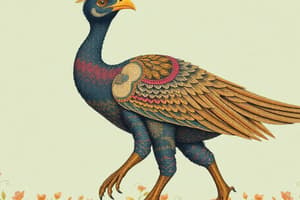Podcast
Questions and Answers
Which adaptation in bird anatomy primarily enables efficient flight through reduced body weight?
Which adaptation in bird anatomy primarily enables efficient flight through reduced body weight?
- Pneumatized bones (correct)
- Thick cross-struts in bones
- A high density of muscular tissue
- Dense connective tissue in the wings
What is the primary role of filoplume feathers in birds?
What is the primary role of filoplume feathers in birds?
- To detect position and movement of contour feathers (correct)
- To attract mates during the breeding season
- To assist in locomotion
- To provide insulation
Which of the following substances has the highest thermal conductivity, making it less suitable for insulation compared to down feathers?
Which of the following substances has the highest thermal conductivity, making it less suitable for insulation compared to down feathers?
- Sheep wool
- Water
- Copper (correct)
- Glass
In birds, how do the adaptations of their lungs facilitate gas exchange during flight?
In birds, how do the adaptations of their lungs facilitate gas exchange during flight?
What structural adaptation in the skeletal system of birds aids in preventing the buckling of bones during flight?
What structural adaptation in the skeletal system of birds aids in preventing the buckling of bones during flight?
What is the primary function of the air sacs in a bird's respiratory system?
What is the primary function of the air sacs in a bird's respiratory system?
Which of the following statements accurately describes the skeletal adaptations of modern birds for flight?
Which of the following statements accurately describes the skeletal adaptations of modern birds for flight?
Which flight muscle in birds is primarily responsible for pulling the wing down during flight?
Which flight muscle in birds is primarily responsible for pulling the wing down during flight?
What feature of bird lungs enables continuous airflow, thus optimizing gas exchange efficiency?
What feature of bird lungs enables continuous airflow, thus optimizing gas exchange efficiency?
What is the main benefit of feathers in relation to flight in birds?
What is the main benefit of feathers in relation to flight in birds?
Which adaptation is specifically associated with improving lift during slow flight in birds?
Which adaptation is specifically associated with improving lift during slow flight in birds?
What primarily allows birds to minimize drag at high speeds?
What primarily allows birds to minimize drag at high speeds?
What mechanism allows barbules to reattach once they have detached?
What mechanism allows barbules to reattach once they have detached?
Which of the following wing adaptations is NOT used for soaring or gliding?
Which of the following wing adaptations is NOT used for soaring or gliding?
What effect does an increased angle of attack have on a bird's flight?
What effect does an increased angle of attack have on a bird's flight?
Flashcards
Bird Flight Muscles
Bird Flight Muscles
Large muscles in birds crucial for flight; attached to the keel and humerus.
Supracoracoideus Muscle
Supracoracoideus Muscle
A bird flight muscle, located under pectoralis and raising the wing.
Pectoralis Muscle
Pectoralis Muscle
The largest bird flight muscle, pulling the wing down.
Bird Lungs - Gas Exchange
Bird Lungs - Gas Exchange
Signup and view all the flashcards
Parabronchi
Parabronchi
Signup and view all the flashcards
Barbules
Barbules
Signup and view all the flashcards
Alula
Alula
Signup and view all the flashcards
Wing-tip slots
Wing-tip slots
Signup and view all the flashcards
Angle of attack
Angle of attack
Signup and view all the flashcards
Types of Bird Wings
Types of Bird Wings
Signup and view all the flashcards
Down Feather Function
Down Feather Function
Signup and view all the flashcards
Down Feather Structure
Down Feather Structure
Signup and view all the flashcards
Filoplume Feather Function
Filoplume Feather Function
Signup and view all the flashcards
Bird Bone Structure
Bird Bone Structure
Signup and view all the flashcards
Synsacrum Function
Synsacrum Function
Signup and view all the flashcards
Study Notes
Bird Evolution and Adaptations
- Birds are a subgroup of vertebrates, specifically the class Osteichthyes (bony fish).
- Birds are divided into two superorders: Neornithes (containing all living birds) and Paleognathae (flightless birds).
- Birds evolved from Theropod dinosaurs.
- Key similarities between birds and Theropods include: bipedal posture, hollow pneumatic bones, and three-fingered feet.
Dinosaur and Bird Resemblance
- Dinosaurs, such as Sinosauropteryx, were intermediate forms between dinosaurs and birds.
- Sinosauropteryx lacked the "twisting" wrist and true flight feathers.
- Archaeopteryx was a close relative of Dromeosaurs and had true feathers, representing a "primitive" form of bird.
- Protarchaeopteryx, had some bird-like features but was likely a dinosaur.
Bird Evolution Hypotheses
- Two hypotheses explaining the evolution of flight in birds are the arboreal theory (jumping between trees) and the terrestrial theory (ground running and flapping).
- Caudipteryx is another example which shares lineages similarities and characteristics with both birds and dinosaurs..
- There are various intermediates between dinosaurs and modern birds according to the fossil record.
Feathers
- Birds have three types of feathers: contour feathers (for flight and body), down feathers (for insulation), and filoplumes (sensory).
- Contour feathers are lightweight but strong and cover the bird's body, streamlining it for flight. They are composed of a quill, shaft, barbs, and barbules.
- Down feathers are soft and fluffy, providing insulation to keep the bird warm.
- Filoplumes are hair-like feathers with nerve endings at their base that communicate information about the position and movement of other feathers.
Bird Skeleton Adaptations
- Bird skeletons are light but strong due to pneumatized bones (and cross-struts).
- The bones have air spaces that connect to air sacs for better breathing during flight.
- Vertebrae (except the neck) are fused, increasing the rigidity of the spine, especially in the synsacrum.
- The sternum has a large keel for the attachment of powerful flight muscles.
Flight Muscles
- Supracoracoideus muscles lift the wings.
- Pectoralis muscles pull the wings down.
- These muscles are highly developed for powerful flight.
Bird Respiration
- Bird lungs are unique, composed of paired lungs and interconnected air sacs.
- Air sacs extend into some bones and are avascular (lack blood vessels).
- Air flows in one direction through the lungs, providing efficient gas exchange.
- The air flow is unidirectional.
- Two breaths are needed to turn over air in the respiratory system.
Bird Wing Types
- Different types of bird wings are adapted for various flight styles, such as elliptical wings (for maneuvering), high-speed wings (for speed), active soaring wings, and passive soaring wings.
Studying That Suits You
Use AI to generate personalized quizzes and flashcards to suit your learning preferences.




